- Getting around Lijiang. Dont stay in the Old Towns more than 2 days, there is nothing to do. KRISS Oct 9, 2013 05:46
- 2013 Beijing Temple Fair BENNYLAU Feb 26, 2013 03:29
- Malaysian traveling from KUL - LAX vis Shanghai PVG ZATI_DY Jan 3, 2013 20:15
<A> A Silk Road Gem
- Views: 4090
- |Vote: 0 0
- |Add to Favorites
- |Recommend to Friends
Before arriving in Xi?an, I only knew the city as a convenient base from which to take day trips to see the famous Terracotta Warriors. They're only a short bus ride away in the surrounding countryside.
But I soon discover that Xi?an is where China?s Silk Road first began more than two thousand years ago, and its influence is still seen here today in the city?s many historical landmarks and beautiful places of worship, including the Great Mosque and the Big Wild Goose Pagoda. Friendly people, open air markets, intriguing neighborhoods and the region?s culinary specialties make a visit to Xi?an a culturally enriching experience not to be forgotten.
The Great Mosque
One of the most prominent reminders of the silk trade is the Great Mosque, with its peaceful gardens, walkways, courtyards, pavilions and pagodas.
Our guide tells me and my several travel companions that much of the structure is in the Ming Dynasty style. However, a mosque has most likely stood on the site since the 7th Century, when it was established to provide Middle Eastern merchants a place to worship. The buildings incorporate many traditional Chinese architectural elements, including several animal figures?a feature not seen in Middle Eastern mosques?that adorn some of the curved corners of the vibrant blue-green tile roofs.
The smell of baking flat bread lures us into the second courtyard, where a woman of Muslim faith is bundling loaves together in a basket. Wandering through the well-manicured grounds, containing white, pink and purple blossoming plants, leads us to the prayer hall, a long rectangular building, lined with a broad stairway and wide porch or platform. Inside the dimly lit hall, the walls are covered with passages from the Koran, some in Chinese and others in Arabic, while the ceiling contains scriptures set among decorative flower carvings.
The Mosque is located in the Huajue Xiang district, and serves the Muslim Hui minority of Xi?an. As we leave the place of worship, I take the time to wind my way through the surrounding marketplace, consisting of a narrow passageway full of wares for avid shoppers. I start to browse among the many stalls full of decorative chopstick boxes, fans and figurines, and before I know it I?m bargaining for a Mahjong set and a set of serving bowls. But the salesperson and I become more interested in talking about where each of us live and what we like about Xi?an.
I decide to hold off on souvenir shopping and wander back toward the main road, noticing the small wooden cages hanging from trees that line the street. Inside are tiny pet birds. A local food market catches my eye so I venture over. Dried fruit and nuts in every size sit in mounds under stalls covered by red tarp, which casts a pink ethereal glow on everyone underneath.
A Silk Market
A visit to a local silk market is fitting stop while in Xi’an, considering the city’s vital contribution to the Silk Road. A tour of the factory shows how time consuming a high quality, hand-woven rug or carpet can be. It can take years to finish just one and requires a deftness in hand-eye coordination that only skilled artisan can provide. The designs are incredibly ornate and consist of an astonishing array of motifs, ranging from scenes depicting the country’s history, to beautiful pastoral panoramas, to complex Chinese patterns of medallions, lotus flowers, floral borders, and birds—the selection seems limitless.
We’re taught that a pure silk rug reflects light in a specific manner. Place it on the floor one way, and the colors appear clear and rich, with an almost iridescent quality. Turn the carpet 180 degrees, and the colors seem to change, becoming more muted but just as beautiful.
Scarves are another specialty of the factory. We’re given a demonstration of tie-dying with natural pigments to create a wonderfully free-form design of bright pinks and yellows. As I browse the selection of scarves, I find a one with a simple pattern of gold flowers on a bright red background and another with a more complex woven design of shimmering teal and silver that I decide to take home.
The City Wall
Another site not to be missed in Xi’an is the City Wall, originating in the Ming Dynasty. A walk on the wall one morning gives me an idea of how massive it is. It rises nearly 40 feet above the ground and stretches for more than 9 miles around the city. The wall is 40 to 45 feet wide at the top and more than 50 feet wide at the bottom. Ninety-eight ramparts were built to fortify the city and still stand today.
Looking down from the East Gate, I see people busy with their morning commute, cycling or walking to work or waiting at their local bus stops. Beautifully manicured gardens and gravel paths run along the side of the wall that borders the inside of Xi’an. Looking over the other side of the wall, there’s a stone walkway, where a man is pushing a cart of vegetables to a local market several yards away.
On a vacant lot, customers mill around motorbikes or bicycles with large carts attached to the back and filled to the brim with piles of yellow, green, white, red and orange produce. Other venders have set up tables under large red, white and green umbrellas on which to place their goods. Some shoppers walk their bikes through the market and put fruit and vegetables into the baskets hanging off their handle bars.
Shouts and giggles ring out several yards away, and I walk along the wall to find a group of about 25 young school children gallivanting on a balcony while on recess. One waves at me. They are dressed in crisp while and light blue uniforms with red scarves tied around their collars. Two boys dart across a courtyard. Another class, somewhat older, sits across the way on the third floor of a building. A few gaze outside at the commotion.
At night, the wall becomes a place for the locals to unwind. With bright red lanterns lining the wall’s perimeter, residents of Xi’an gather near the South Gate to socialize and ballroom dance.
A Food Lover’s Delight
The next day, an afternoon lunch break brings me and my travel companions to the Tang Dynasty Palace, where we learn that dumplings are the local specialty. Basket after basket of little savory parcels arrive containing a variety of fish, shrimp, chicken, pork, bean paste and vegetables, at least 16 kinds in all. Some are steamed, others are fried. Some are purse-shaped, some are flower-shaped, while others still are round or triangular. A mini-dumpling soup finishes the meal. It arrives in a boiling hot caldron emitting blue and green flames. The flavors are much cleaner and more delicate and complex than what I can find in back home in the United States.
Big Wild Goose Pagoda
On visiting the Big Wild Goose Pagoda, we learn that the old trade routes that were once the Silk Road helped to bring Buddhism to China. This pagoda was built under the Tang Dynasty to house translations of Sanscrit texts that the Chinese Monk Xuan Zang brought back from his famous journey to India.
Instead of climbing to the top of the more than 200-ft tall pagoda for views of immaculately landscaped grounds, I choose to wander around down below. The surrounding one-storey buildings with their grey tile roofs, with accents of blue, red and gold under their eaves, are set among the lush greenery of trees, bushes and ivy, creating a cool oasis on a warm day in Xi’an.
My walk leads me to a small group of people burning candles in front of the temple, a quiet offering for Buddha.
Terracotta Warriors
And while these many sites wait in Xi’an, the trip isn’t complete without an excursion to the Terracotta Warriors. The archeological site consists of three main excavation pits filled with approximately 8000 warriors and their horses, created to guard the emperor Qin Shi Huang more than two thousand years ago. These warriors accidentally surfaced in 1974 after a local farmer pulled up a terracotta artifact from his well. Today you can find him signing books in the gift shop.
A least 6,000 faces look out of the first of three pits. We’re told each one is different because they are modeled on actual soldiers who lived more than 2000 years ago. The pinkish-gray terracotta army stands vigilantly with their horses to protect the emperor against intruders. We learn that each was vividly painted when they were created. I look closely. Is that a hint of red paint that I can still see?
Each warrior stands taller than their original human counterpart to intimidate invaders. Their hands are carefully poised and ready for action, but their bronze weapons are gone, the victims of looters over the centuries.
Our visit takes us to two more pits of warriors still undergoing excavation. The first contains more than 1300 figures, including infantry, archers, cavalry, and soldiers to man the chariots. I see some terracotta figures still toppled in the earth, waiting to have the dirt and dust carefully cleared off of them. The third pit is the smallest and we’re told this is likely the command center for the army because of how the figures are arranged, facing each other, as opposed to battle formation. It contains less than 70 human figures and a several horses.
As we leave the museum and drive through the countryside, one of my travel companions points out a triangular grass covered mound of earth. More tombs, our guide tells us. I wonder what discoveries await here and elsewhere in Xi’an.



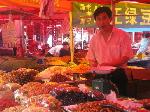
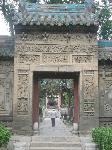

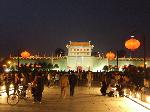
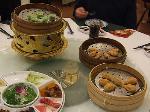
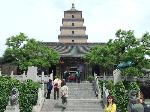
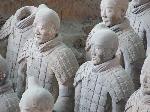
 Copyright © 1998-2025 All rights reserved.
Copyright © 1998-2025 All rights reserved.